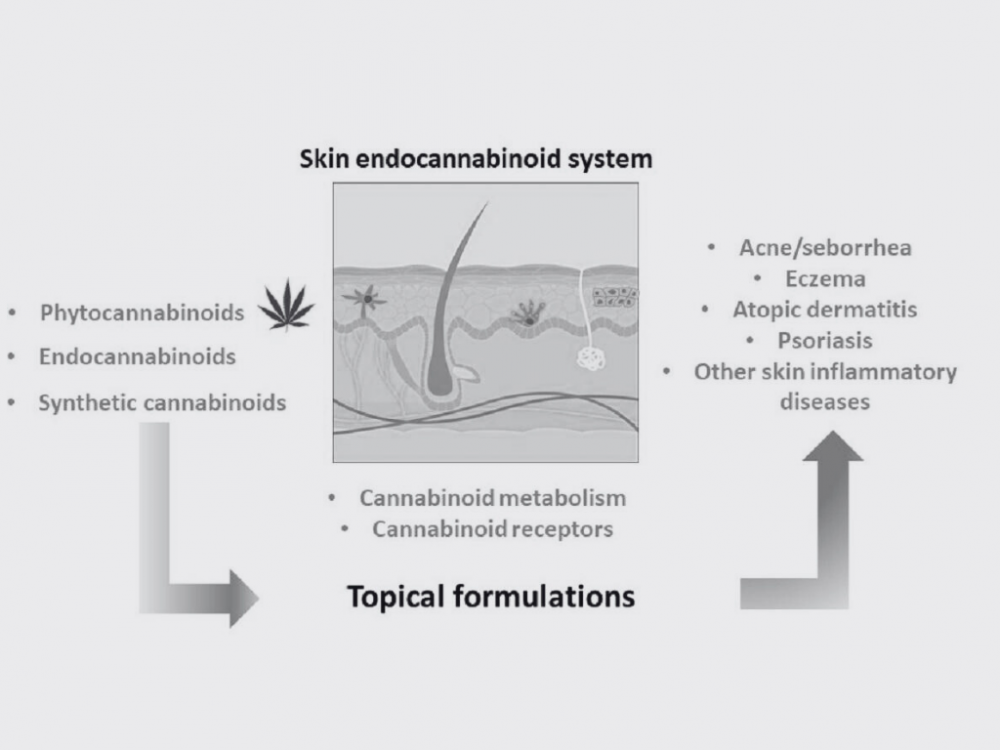
Anatomy of the Skin Endocannabinoid System
The human body operates through a complex network of receptors known as the endocannabinoid system (ECS). This system, composed of cannabinoid receptors, endocannabinoids (naturally occurring compounds), and the enzymes responsible for their production and breakdown, plays a critical role in maintaining various physiological functions. Surprisingly, the skin, being the body’s largest organ, also possesses its own endocannabinoid system, which interacts with compounds found in cannabis. This interaction has opened doors to explore the potential medical applications of cannabis in dermatology and skincare.
Overview of the Endocannabinoid System
The ECS is comprised primarily of two cannabinoid receptors: CB1 and CB2. CB1 receptors are predominantly found in the central nervous system, while CB2 receptors are mainly distributed in the immune system and peripheral tissues, including the skin. When activated by endocannabinoids (compounds produced naturally by the body) or phytocannabinoids (cannabinoids from cannabis), these receptors initiate various biological responses within the body.
Cannabinoids in Cannabis
Cannabis is home to over 100 different cannabinoids, with delta-9-tetrahydrocannabinol (THC) and cannabidiol (CBD) being the most well-known. THC is the psychoactive compound responsible for the “high” associated with cannabis use, while CBD lacks psychoactive properties and has gained attention for its potential therapeutic benefits.
Effects of Cannabinoids on the Skin
Cannabinoids, when applied topically or introduced into the body, interact with the skin’s endocannabinoid system, offering potential advantages for various skin conditions. For instance, CBD has demonstrated anti-inflammatory properties that could help alleviate symptoms related to conditions like acne, psoriasis, and eczema by regulating the immune response and reducing inflammation. Furthermore, CBD exhibits antioxidant effects that may combat oxidative stress, a process linked to skin aging.
Research and Studies
Scientific investigations have delved into the possible therapeutic applications of cannabis in dermatology. One study, published in the Journal of Clinical Investigation, revealed that CBD could reduce sebum production and exert anti-inflammatory effects on human sebocytes, suggesting its potential use in acne treatment. Another study showed that CBD cream decreased the severity of skin conditions such as allergic contact dermatitis.
Potential Medical Uses of Cannabis in Dermatology
- Acne: CBD’s anti-inflammatory properties, regulation of sebum production, and antimicrobial effects may offer an alternative treatment for acne.
- Psoriasis: Early research suggests that cannabinoids could regulate immune responses in psoriasis, potentially reducing symptom severity.
- Eczema: CBD’s anti-inflammatory properties may help manage eczema symptoms by reducing itchiness, redness, and dryness.
- Aging and Wrinkles: CBD’s antioxidant properties may protect the skin from oxidative stress, potentially delaying signs of aging.
The skin’s endocannabinoid system plays a crucial role in maintaining skin balance, and its interaction with cannabinoids presents intriguing possibilities for therapeutic applications in dermatology. While further research is required to fully grasp the benefits, current scientific literature suggests that cannabis compounds, particularly CBD, hold promise for managing various skin conditions characterized by inflammation and immune dysfunction.
📗 Note: This diagram is like a teaser. Want to binge the whole season? Stream “The Doctor-Approved Cannabis Handbook” through this link 📗.

Summary Notes
Delving into the Anatomy of the Skin’s Endocannabinoid System
The skin’s endocannabinoid system (ECS) represents a complex network of receptors, enzymes, and endogenous cannabinoids that play a pivotal role in maintaining cutaneous homeostasis and health. An understanding of the ECS’s anatomy within the skin unveils its multifaceted roles in regulating various physiological processes, from barrier formation and maintenance to inflammation and cell proliferation.
The presence of cannabinoid receptors CB1 and CB2 across different dermal layers signifies the ECS’s extensive influence. These receptors, alongside the enzymes responsible for the synthesis and degradation of endocannabinoids, orchestrate the skin’s responses to internal and external stressors, facilitating tissue repair, barrier function, and immune response.
Research into the interaction between phytocannabinoids and the skin’s ECS has opened new avenues for treating a range of dermatological conditions. By modulating ECS activity, cannabinoids hold promise in addressing inflammatory skin diseases, wound healing, and even skin cancer, highlighting the therapeutic potential of targeting this system.
Advancements in our understanding of the ECS’s signaling pathways and mechanisms of action within the skin continue to refine our approach to dermatological therapy. The application of topical formulations designed to interact with the skin’s ECS offers a novel method for influencing skin health directly, with ongoing studies aiming to optimize their efficacy and safety.
Despite the promising therapeutic implications, challenges remain in fully elucidating the skin’s ECS anatomy and function. Future research directions are poised to further unravel the complexities of this system, enhancing our capacity to harness its potential for skin health and disease treatment.
As the field of dermatology continues to explore the ECS’s vast potential, the development of targeted therapies and skincare products offers hope for improved management of skin conditions. Educating healthcare professionals and patients on the intricacies of the skin’s endocannabinoid system is crucial for integrating these advances into clinical practice, paving the way for novel treatments that leverage the ECS for enhanced dermatological outcomes.

